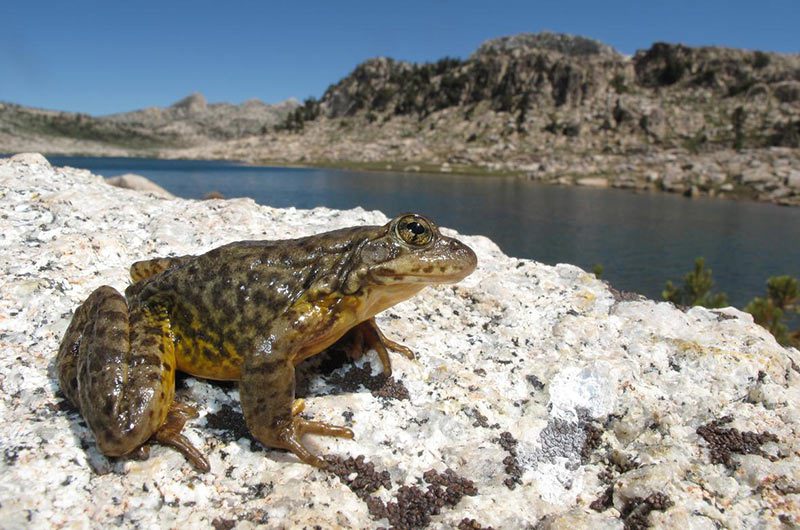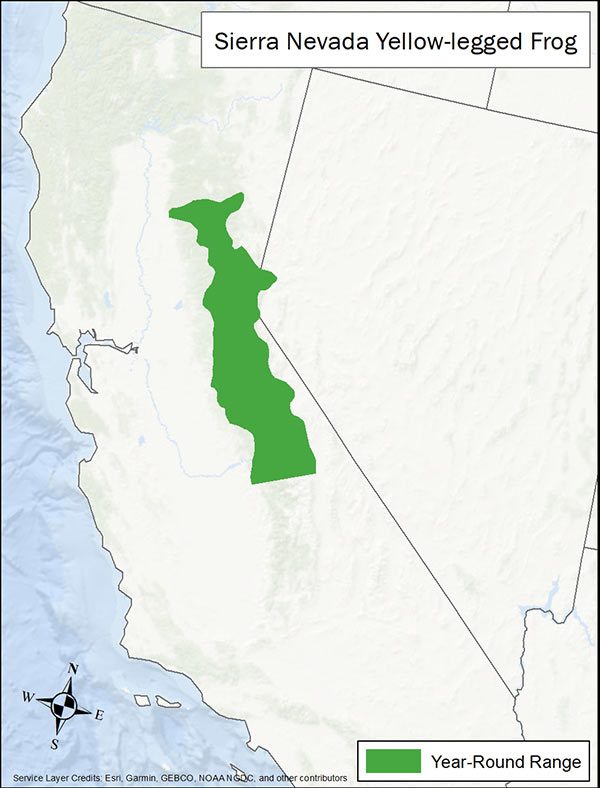LandPKS Learning
Habitat Hub

Sierra Nevada Yellow-legged Frog
Sierra Nevada yellow-legged frogs will produce a mink- or garlic-like odor when disturbed or threatened. This odor is used to discourage predators.
Rana sierra
Identification
Sierra Nevada yellow-legged frog is a medium sized frog at 1.5-3.25 in/4-8 cm. Male frogs are slightly smaller than females. These yellow-legged frogs are a mix of brown and yellow coloring on the upper body, usually with dark spots. However, coloration is highly variable, as they can also be grey, red, or greenish-brown. The underside of the body and back legs and sometimes the front legs are yellow or light-orange. The frog’s throat is white or yellow. Sierra Nevada yellow-legged frog is listed as Endangered in the United States and considered a Threatened species in California.
Observation Tips
Sierra Nevada yellow-legged frogs are found at high elevations in the Sierra Nevada Mountains in California on National Forest and National Park Service lands. They have been extirpated from 70% of their historic locations, including those previously known from Nevada. They make a flat clicking sound either in or out of the water. Sierra Nevada yellow-legged frogs can often be found sitting on roads along the shoreline of lakes and streams. These frogs spend the winter at the bottom of surface-frozen lakes, becoming active and laying eggs soon after the snow melts. In some years, they are only active for a few months. Tadpoles live in these ponds over the winter and can take up to four years to become adults.
Interesting Fact
Sierra Nevada yellow-legged frogs will produce a mink- or garlic-like odor when disturbed or threatened. This odor is used to discourage predators.
Ideal Habitat
Sierra Nevada yellow-legged frogs live in fishless lakes, ponds, streams, marshes, and meadows at high elevations (>3500 ft/1067 m). At higher elevations, they are often found in small steep-banked mountain lakes and pools called tarns, while at lower elevations, they are found in wet meadows and rocky streams surrounded by conifer forests. When basking at the edge of ponds or streams, the habitat is usually rocky with little or no vegetation, and they are rarely seen more than 3.3 ft/1 m from water. These frogs eat a variety of invertebrates, both terrestrial and aquatic, as well as tadpoles.

Range map provided by International Union for Conservation of Nature
Management Activities that Benefit Species – Best Management Practices (BMPs)
Maintain high quality montane lakes, ponds, meadows, and streams. Restore degraded wetland and riparian habitat to provide connected habitat for Sierra Nevada yellow-legged frogs. Climate change is also thought to be a significant threat as drought persists and increases in frequency. Activities that promote resilience of occupied lakes and streams should be continued including removal of nonnative species and increasing native species diversity. Allowing and participating in research on existing stable and growing Sierra Nevada yellow-legged frogs populations may provide future strategies to expand more populations. Eradicate fish in adjacent unoccupied habitats to allow Sierra Nevada yellow-legged frog populations to expand.
Management Activities to Avoid
Avoid introducing fish and other frogs into naturally fishless habitat occupied by Sierra Nevada yellow-legged frogs as these species will prey upon yellow-legged eggs and frogs. A more recent threat is the often fatal chytrid fungus. As this disease may have been transmitted with introductions, avoiding introducing new species into an occupied habitat.
Other Species that Benefit from Similar Habitat Management
Garter snakes, gray crowned rosy finch, and many aquatic macroinvertebrates will benefit from management for Sierra Nevada yellow-legged frogs. .
Download
Download the Sierra Nevada Yellow-legged Frog factsheet
Other Resources
International Union for Conservation of Nature (IUCN). 2014. The IUCN Red List of Threatened Species. Version 2021-1 Rana sierra
National Park Service Yosemite. Sierra Nevada yellow-legged frog
NatureServe. 2021. NatureServe Explorer: An online encyclopedia of life [web application]. Version 7.1. NatureServe, Arlington, Virginia. Sierra Nevada yellow-legged frog
USFWS Species Information. Sierra Nevada Yellow-legged Frog
Mobile App | Data Portal | Knowledge Hub | Habitat Hub | Learning Collections | Blog | About | Contact | Support



